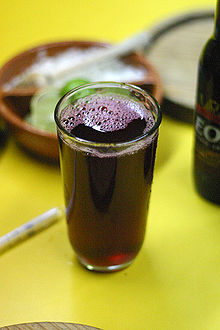Hibiscus tea


Hibiscus tea is a herbal tea made as an infusion from crimson or deep magenta-colored calyces (sepals) of the roselle (Hibiscus sabdariffa) flower. It is consumed both hot and cold. It has a tart, cranberry-like flavor.
Consumption
Africa
The roselle hibiscus used to make the tea likely originated in Africa.[1] In Africa, hibiscus tea is commonly sold in markets and the dried flowers can be found throughout West and East Africa. Variations on the drink are popular in West Africa and parts of Central Africa. In Senegal, bissap is known as the "national drink of Senegal". Hibiscus tea is often flavored with mint or ginger in West Africa. In Ghana it is known as "sobolo", and "zobo" in Nigeria.
Karkadé (كَركَديه karkadīh) is served hot or chilled with ice. It is consumed in some parts of North Africa, especially in Egypt and Sudan.[2] In Egypt and Sudan, wedding celebrations are traditionally toasted with a glass of hibiscus tea. On a typical street in central Cairo, many vendors and open-air cafés sell the drink.[2]
In Sudan, people use hibiscus tea, or karkadé, in folk medicine to treat many health conditions. Pharmaceutical researchers who have studied specimens from Sudan have suggested that its efficacy may relate to its anthocynanins, chemicals that can boost immune responses and combat inflammation, diabetes, cancer, and viral infections.[3][4]
Americas


Agua de flor de Jamaica, also called agua de Jamaica and rosa de Jamaica, is popular in Mexico, Central America, and parts of South America and the Caribbean. It is one of several common
In Panama, both the flowers and the drink are called saril (a derivative of the English word sorrel). It is prepared by picking and boiling the calyces with chopped ginger, sugar, clove, cinnamon, and nutmeg. It is traditionally drunk around Christmas and Chinese New Year, diverging from Mexico and Central America and much more in line with the Caribbean, due to the strong West Indian influence in Panamanian culture especially in Panama City and most of Panama's Caribbean coast.
In the English-speaking Caribbean, the drink, called sorrel, is made from the calyces, and it is considered an integral part of Christmas celebrations. The
In American
Southeast Asia
In Thailand, most commonly, roselle is prepared as a cold beverage, heavily sweetened and poured over ice, similar to sweetened fruit juices. Plastic bags filled with ice and sweetened 'grajeab' can be found outside of most schools and in local markets. It is less commonly made into a wine, sometimes combined with Chinese tea leaves, in the ratio of 4:1 by weight (1⁄5 Chinese tea). The beverage is consumed in Malaysia, Cambodia and Indonesia as well.
Europe
In
Research
Reviews have concluded that hibiscus tea consumption appears to modestly lower blood pressure in people with
References
- ^ "Roselle - plant". Encyclopedia Britannica. 24 September 2023.
- ^ Saudi Aramco World. Saudi Aramco. Retrieved 1 June 2008.
- S2CID 37341345.
- PMID 28970777.
- ^ "Sorrel recipe". jamaicatravelandculture.com.
- ^ Adrian Miller (23 June 2015). "In Praise of Red Drink: The Origin Story Behind Soul Food's Most Iconic Beverage". First We Feast. Retrieved 8 February 2019.
- ^ PMID 23333908.
- S2CID 19042199.
- S2CID 210333560.
Further reading
- Information about Roselle by J. Morton (1987), part of the New Crop Resource Online Program at Purdue University
